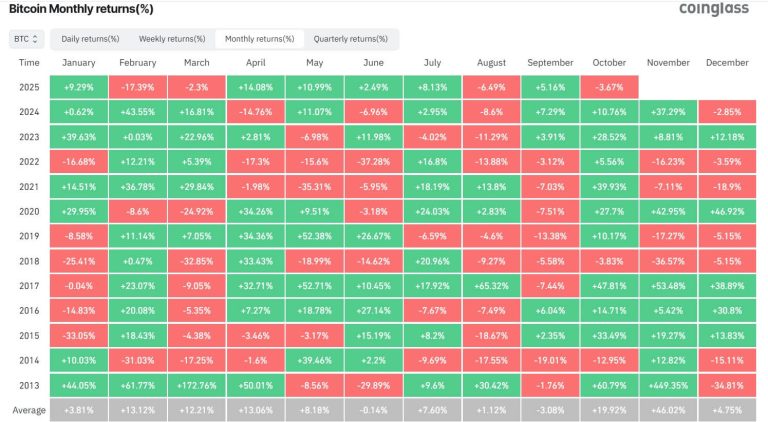For more than a decade, October has been one of Bitcoin’s easiest months to be bullish.
Historically, it has delivered average gains of about 22.5%, helped by post-summer liquidity, year-end portfolio positioning, and, more recently, steady demand from US investment products.
As a result, confidence in that pattern was high again this year. And true to form, Bitcoin set a new record above $126,000 in the first week of the month as traders quickly revived the familiar “Uptober” slogan.
However, a flash sell-off erased those early gains within days, and unlike tech stocks and other risk assets, Bitcoin never recovered its value.
This resulted in the month closing lower, the meme failing, and the market was reminded that slogans don’t absorb supply.
Echoes of 2018
What makes this October notable is how closely it rhymes with 2018.
Back then, October didn’t collapse as it simply stopped rallying. Once that usual seasonal tailwind faded, November and December turned sharply lower, with Bitcoin losing more than 36% in November alone.
The takeaway was simple: when a historically strong month fails to lift prices, underlying weakness is already in play. That weakness can stem from excess supply, fading demand, or even tighter macroeconomic conditions.
This year carries a similar undertone. The calendar didn’t stop working. Instead, the market came into October exhausted.
After a strong first three quarters, traders were heavily positioned, liquidity was uneven, and long-term holders began taking profits into every sign of strength.
Why did Bitcoin price fall in October?
On-chain data explains most of why the Bitcoin price struggled in October.
Data from the blockchain analytics platform Glassnode showed that long-term BTC holders have been steadily spending coins since mid-July, increasing realized selling from approximately $1 billion a day to between $2 billion and $3 billion a day by early October.
It noted:
“Filtering by age cohort reveals that 6m–12m holders drove over 50% of recent sell pressure—especially during the late stages of the top formation. Around the $126,000 ATH, their spending exceeded $648M/day (7D-SMA); over 5x their baseline earlier in 2025.”
Crucially, this distribution was not a panic spike like prior capitulation events. It was gradual, persistent, selling into every show of strength.
According to the firm, many of the coins originated from wallets that had been purchased for between $70,000 and $96,000, resulting in an average cost of nearly $93,000.
This suggests that the move looks more like profit-taking after a strong year rather than a fear of a downturn.
At the same time, Bitcoin’s poor performance was compounded by the fact that its buy side significantly thinned out in October.
In its weekly report, crypto analytical platform CryptoQuant noted a noticeable slowdown in US investor appetite across spot markets, ETFs, and futures following the late-September rally.
Indeed, ETF inflows cooled significantly to less than 1,000 BTC/day, which was considerably lower than the average of over 2,500 BTC/day seen at the start of major rallies this cycle.
Additionally, spot exchange premiums narrowed, and the futures basis retreated.
Moreno noted that these were signals that the marginal US buyer stepped back right when long-term holders stepped up their selling.
Meanwhile, the macro backdrop also amplified the drag.
This year has been dominated by trade frictions—especially between the US and China—and flare-ups in the Middle East. The Federal Reserve has also continued to signal a restrictive policy stance, maintaining tight global dollar liquidity.
Considering all of this, research platform Kronos framed the October pullback as a “liquidity strain, not a trend break,” noting that Bitcoin still behaved as a relative flight-to-safety asset even as leveraged longs were flushed out.
What’s next for BTC?
The uncomfortable parallel for bulls is that the last red October preceded a difficult year-end.
In 2018, the loss of seasonal support was followed by thinner liquidity, more decisive long-term holder distribution, and buyers waiting several legs lower.
However, today’s market is healthier because the investor base is deeper, stablecoin liquidity is larger, and regulated products now provide a slower, steadier bid that simply did not exist seven years ago.
Considering this, Timothy Misir, head of research at BRN, described the current setup as a market that is “recalibrating, not collapsing,” adding that institutional accumulation continues beneath the surface as long as Bitcoin holds above the $107,000–$110,000 zone.
Even so, the October print changes the conversation. When Bitcoin cannot rally in the month it usually rallies, the burden of proof shifts to the bulls.
The final two months of the year are likely to be defined less by memes about Uptober and more by whether long-term holder spending cools back toward $1 billion a day and whether US ETF flows reaccelerate.
If supply stays heavy and the regulated bid stays light, 2025 could echo 2018 with a choppy, frustrating finish to the year. However, if flows return and geopolitics calm, October may end up looking less like the start of a slide and more like a brief, orderly handoff from older holders to new ones.
The post Here is why Bitcoin registered its first red October in 7 years appeared first on CryptoSlate.



